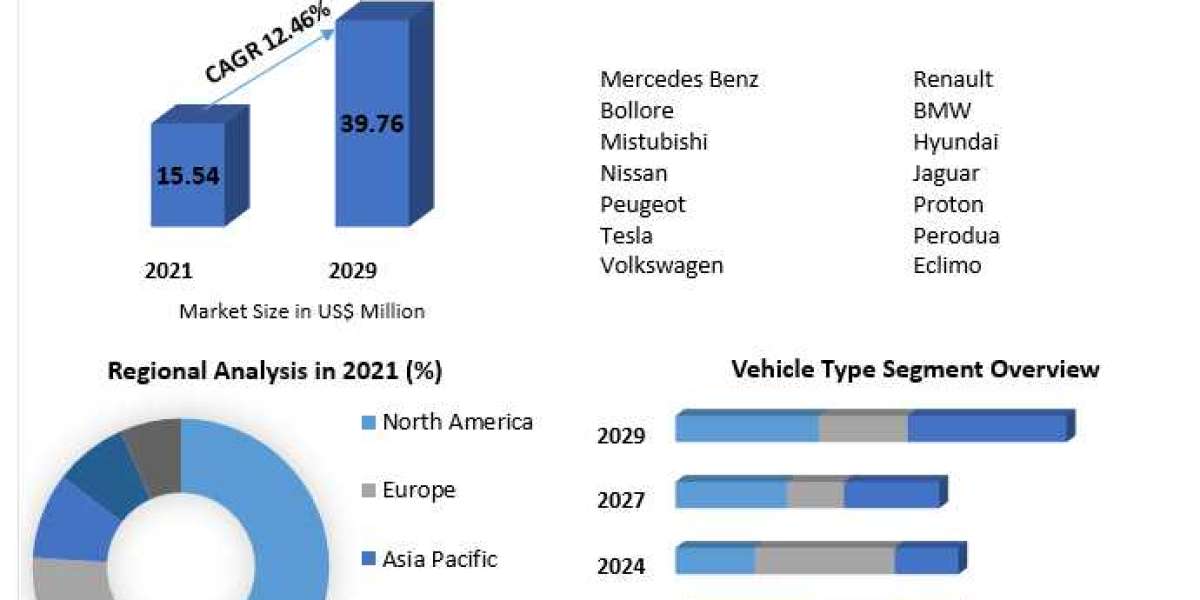Malaysia's electric vehicle (EV) market is on a robust growth trajectory, with projections indicating an increase from USD 15.54 million in 2021 to approximately USD 39.76 million by 2029, reflecting a compound annual growth rate (CAGR) of 12.46% during the forecast period.
Malaysia Electric Vehicle Market Definition and Scope
Electric vehicles (EVs) are powered entirely or partially by electricity, offering an eco-friendly alternative to traditional internal combustion engine vehicles. In Malaysia, the EV market encompasses passenger cars, motorcycles, and commercial vehicles, with a focus on promoting sustainable transportation solutions.
Download your sample copy of this report today: https://www.maximizemarketresearch.com/request-sample/65822/
Malaysia Electric Vehicle Market Growth Drivers and Opportunities
Several factors are contributing to the robust expansion of Malaysia's EV market:
Government Initiatives: The Malaysian government has implemented policies to encourage the adoption of electric vehicles, including tax exemptions and incentives for EV manufacturers and consumers. As of 2022, electric vehicles are exempt from Malaysian road taxes and import duties.
Infrastructure Development: Efforts are underway to enhance the EV charging infrastructure across the country. As of 2021, there were 251 public charging stations in Malaysia, with plans to increase this number to 1,000 by 2025.
Consumer Awareness: Increasing public knowledge about the environmental benefits of EVs is driving consumer interest and adoption. Educational campaigns and test-drive events are being organized to familiarize consumers with electric vehicles.
Automotive Industry Participation: Local automotive manufacturers, such as Proton, are developing electric vehicle models, contributing to the growth of the domestic EV market. Proton's model, the Proton Iriz EV, was showcased as the first locally produced electric vehicle.
Excited to dive in? Request your sample copy of the report to uncover its contents: https://www.maximizemarketresearch.com/request-sample/65822/
Malaysia Electric Vehicle Market Segmentation Analysis
The Malaysian EV market is segmented based on vehicle type and application:
By Vehicle Type:
- Passenger Cars: The largest segment, driven by consumer demand for eco-friendly personal transportation.
- Motorcycles and Scooters: Growing in popularity due to their affordability and suitability for urban commuting.
- Commercial Vehicles: Emerging segment with potential for fleet electrification in logistics and public transportation.
By Application:
- Urban Transportation: High adoption rates in metropolitan areas with supportive infrastructure.
- Rural Transportation: Potential for growth with targeted policies and infrastructure development.
Curious to peek inside? Grab your sample copy of this report now: https://www.maximizemarketresearch.com/request-sample/65822/
Regional Insights
The EV market is experiencing varied growth across Malaysia's regions:
- Kuala Lumpur and Selangor: Leading in EV adoption due to higher income levels and better infrastructure.
- Penang and Johor: Emerging markets with increasing interest in electric vehicles.
- East Malaysia (Sabah and Sarawak): Potential for growth with targeted government initiatives and infrastructure development.
Malaysia Electric Vehicle Market Competitive Landscape
The Malaysian EV market is characterized by the presence of both local and international players:
- Proton: Developing electric vehicle models, such as the Proton Iriz EV.
- Perodua: Engaged in research and development of electric and hybrid vehicles.
- International Brands: Companies like Tesla have been approved to establish a presence in Malaysia, indicating a competitive market landscape.
Looking to gain insights into market trends? Explore the summary of the research report: https://www.maximizemarketresearch.com/market-report/malaysia-electric-vehicle-market/65822/
Conclusion
Malaysia's electric vehicle market is poised for significant growth, driven by supportive government policies, infrastructure development, and increasing consumer awareness. As the market evolves, stakeholders are presented with substantial opportunities to invest in and contribute to the sustainable transportation sector.
Check out our trending studies to understand industry shifts :
Global Automotive Power Sliding Door Market https://www.maximizemarketresearch.com/market-report/global-automotive-power-sliding-door-market/99008/
Snow Removal Market https://www.maximizemarketresearch.com/market-report/global-snow-remover-market/4586/
Global Marine Ports and Services Market https://www.maximizemarketresearch.com/market-report/global-marine-ports-and-services-market/31347/
Key Offerings:
- Past Market Size and Competitive Landscape (2018 to 2023)
- Past Pricing and price curve by region (2018 to 2023)
- Market Size, Share, Size Forecast by different segment | 2024−2030
- Market Dynamics – Growth Drivers, Restraints, Opportunities, and Key Trends by Region
- Market Segmentation – A detailed analysis by segment with their sub-segments and Region
- Competitive Landscape – Profiles of selected key players by region from a strategic perspective
- Competitive landscape – Market Leaders, Market Followers, Regional player
- Competitive benchmarking of key players by region
- PESTLE Analysis
- PORTER'S ANALYSIS
- Value chain and supply chain analysis
- Legal Aspects of Business by Region
- Lucrative business opportunities with SWOT analysis
- Recommendations
About Maximize Market Research:
Maximize Market Research is a multifaceted market research and consulting company with professionals from several industries. Some of the industries we cover include medical devices, pharmaceutical manufacturers, science and engineering, electronic components, industrial equipment, technology and communication, cars and automobiles, chemical products and substances, general merchandise, beverages, personal care, and automated systems. To mention a few, we provide market-verified industry estimations, technical trend analysis, crucial market research, strategic advice, competition analysis, production and demand analysis, and customer impact studies.
Contact Maximize Market Research:
3rd Floor, Navale IT Park, Phase 2
Pune Banglore Highway, Narhe,
Pune, Maharashtra 411041, India
sales@maximizemarketresearch.com
+91 96071 95908, +91 9607365656











